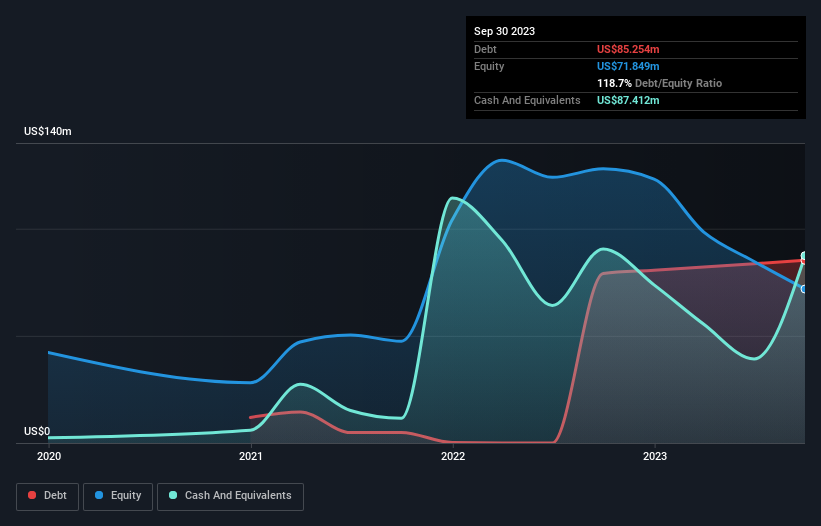- United States
- /
- Healthcare Services
- /
- NasdaqCM:TOI
Is Oncology Institute (NASDAQ:TOI) A Risky Investment?
Legendary fund manager Li Lu (who Charlie Munger backed) once said, 'The biggest investment risk is not the volatility of prices, but whether you will suffer a permanent loss of capital.' It's only natural to consider a company's balance sheet when you examine how risky it is, since debt is often involved when a business collapses. We can see that The Oncology Institute, Inc. (NASDAQ:TOI) does use debt in its business. But the more important question is: how much risk is that debt creating?
Why Does Debt Bring Risk?
Debt and other liabilities become risky for a business when it cannot easily fulfill those obligations, either with free cash flow or by raising capital at an attractive price. Ultimately, if the company can't fulfill its legal obligations to repay debt, shareholders could walk away with nothing. However, a more usual (but still expensive) situation is where a company must dilute shareholders at a cheap share price simply to get debt under control. Of course, the upside of debt is that it often represents cheap capital, especially when it replaces dilution in a company with the ability to reinvest at high rates of return. When we think about a company's use of debt, we first look at cash and debt together.
View our latest analysis for Oncology Institute
How Much Debt Does Oncology Institute Carry?
As you can see below, at the end of September 2023, Oncology Institute had US$85.3m of debt, up from US$79.1m a year ago. Click the image for more detail. However, its balance sheet shows it holds US$87.4m in cash, so it actually has US$2.16m net cash.

How Strong Is Oncology Institute's Balance Sheet?
Zooming in on the latest balance sheet data, we can see that Oncology Institute had liabilities of US$32.4m due within 12 months and liabilities of US$114.1m due beyond that. On the other hand, it had cash of US$87.4m and US$48.9m worth of receivables due within a year. So it has liabilities totalling US$10.2m more than its cash and near-term receivables, combined.
Since publicly traded Oncology Institute shares are worth a total of US$123.9m, it seems unlikely that this level of liabilities would be a major threat. Having said that, it's clear that we should continue to monitor its balance sheet, lest it change for the worse. While it does have liabilities worth noting, Oncology Institute also has more cash than debt, so we're pretty confident it can manage its debt safely. The balance sheet is clearly the area to focus on when you are analysing debt. But it is future earnings, more than anything, that will determine Oncology Institute's ability to maintain a healthy balance sheet going forward. So if you want to see what the professionals think, you might find this free report on analyst profit forecasts to be interesting.
In the last year Oncology Institute wasn't profitable at an EBIT level, but managed to grow its revenue by 33%, to US$310m. With any luck the company will be able to grow its way to profitability.
So How Risky Is Oncology Institute?
By their very nature companies that are losing money are more risky than those with a long history of profitability. And in the last year Oncology Institute had an earnings before interest and tax (EBIT) loss, truth be told. Indeed, in that time it burnt through US$52m of cash and made a loss of US$61m. But at least it has US$2.16m on the balance sheet to spend on growth, near-term. With very solid revenue growth in the last year, Oncology Institute may be on a path to profitability. Pre-profit companies are often risky, but they can also offer great rewards. When analysing debt levels, the balance sheet is the obvious place to start. But ultimately, every company can contain risks that exist outside of the balance sheet. Case in point: We've spotted 2 warning signs for Oncology Institute you should be aware of, and 1 of them is potentially serious.
At the end of the day, it's often better to focus on companies that are free from net debt. You can access our special list of such companies (all with a track record of profit growth). It's free.
New: AI Stock Screener & Alerts
Our new AI Stock Screener scans the market every day to uncover opportunities.
• Dividend Powerhouses (3%+ Yield)
• Undervalued Small Caps with Insider Buying
• High growth Tech and AI Companies
Or build your own from over 50 metrics.
Have feedback on this article? Concerned about the content? Get in touch with us directly. Alternatively, email editorial-team (at) simplywallst.com.
This article by Simply Wall St is general in nature. We provide commentary based on historical data and analyst forecasts only using an unbiased methodology and our articles are not intended to be financial advice. It does not constitute a recommendation to buy or sell any stock, and does not take account of your objectives, or your financial situation. We aim to bring you long-term focused analysis driven by fundamental data. Note that our analysis may not factor in the latest price-sensitive company announcements or qualitative material. Simply Wall St has no position in any stocks mentioned.
About NasdaqCM:TOI
Oncology Institute
An oncology company, provides various medical oncology services in the United States.
Moderate risk and fair value.
Similar Companies
Market Insights
Weekly Picks


Crazy Undervalued 42 Baggers Silver Play (Active & Running Mine)


Fiducian: Compliance Clouds or Value Opportunity?

Willamette Valley Vineyards (WVVI): Not-So-Great Value
Recently Updated Narratives

Moderation and Stabilisation: HOLD: Fair Price based on a 4-year Cycle is $12.08


Positioned globally, partnered locally


When will fraudsters be investigated in depth. Fraud was ongoing in France too.
Popular Narratives


MicroVision will explode future revenue by 380.37% with a vision towards success


NVDA: Expanding AI Demand Will Drive Major Data Center Investments Through 2026





